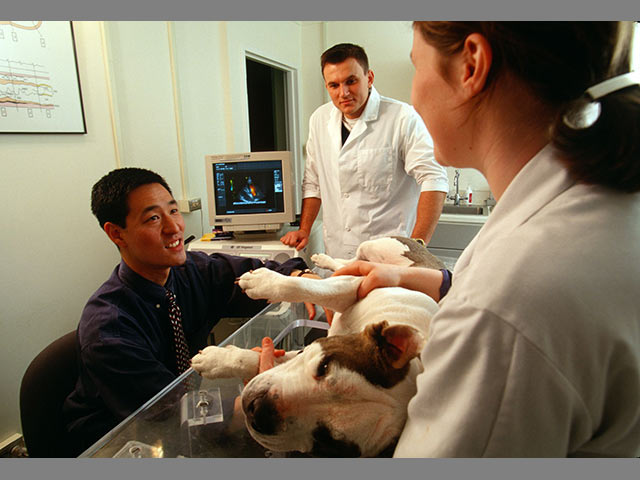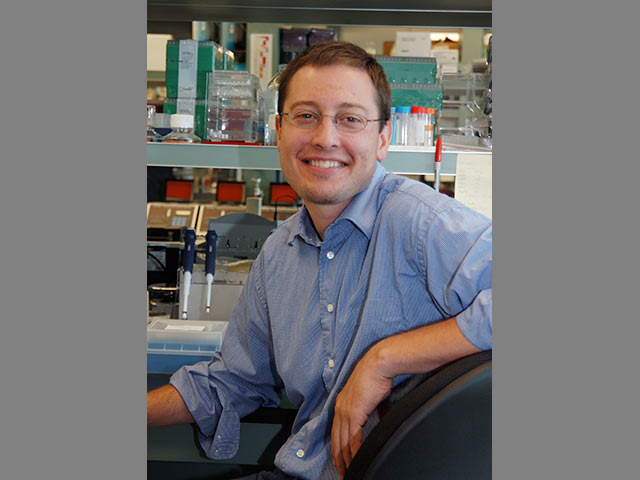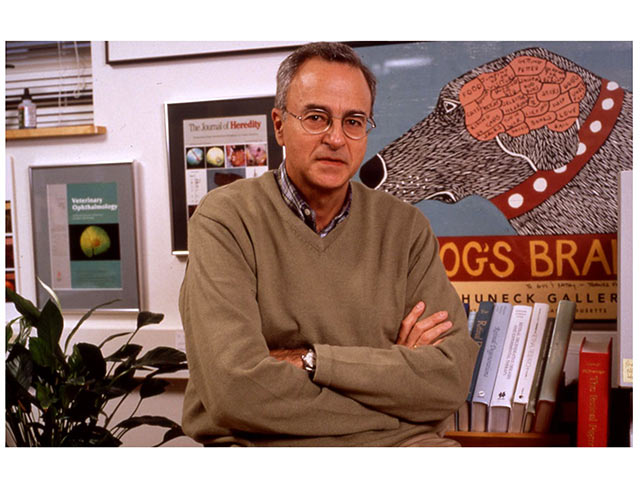Researcher-Breeder Partnerships







Gregory Acland, a geneticist at Cornell studying retinal diseases, says, "The advice we used to give was, don't breed too many dogs that have a problem. That was very short-sighted." That older way of making breeding choices, based only on a dog's obvious traits, or phenotypes, such as coloration, head shape, or hip condition, ignored potent invisible forces bearing on an animal's characteristics. Phenotype-based breeding allows a defect to continue, since the breeder may mate two animals that do not express the defect visibly. "You could have a dog that looks normal, but you don't know its genetics," explains Dr. Gustavo Aguirre, a geneticist at Cornell University. Looking only at phenotype, breeders may remove dogs with wonderful characteristics from breeding based on a single bad trait. Also, a dog could be born with defects, and the breeder "Won't know how it was inherited and how it could be controlled," Dr. Aguirre says.
A better approach is to look at the phenotype as well as the DNA. Dr. Aguirre says understanding genetics allows a breeder to "take any dog, affected or not, breed it to a normal dog, and you'll never produce an affected dog." Knowing the DNA gives breeders the best possibilities: they can make precise improvements, and have a larger potential breeding population.
There are two steps in determining a defect's genetic basis. First, researchers look for common traits among dogs with the same phenotype. For example, Dr. George M. Strain, who studies canine deafness at Louisiana State University, has found that deaf dogs commonly have blue eyes and white skin or fur. Knowing the phenotype, a researcher then begins to seek genetic similarities in affected dogs. Dr. Strain says this second stage involves doing a labor-intensive study of "short stretches of DNA called micro-satellites," as many as 170 of them, one at a time. It is like comparing 10 dictionaries, page by page, to find one with a misprint. In Dr. Strain's study, he looks at each micro-satellite, comparing deaf dogs to hearing dogs, until he finds one "that shows up only in the deaf dogs"—the one with the misprint. He is then very close, and can zero in on the gene, or set of genes, causing deafness. Once the defective genes are isolated, a blood- or skin-based test can be developed to test any dog at any age.
But doing genetic research requires access to large numbers of dogs. The only way researchers can see enough purebred dogs is through partnerships with breeders and breed clubs.
The range of genetic issues being studied at veterinary colleges encompasses all breeds and hundreds of health issues. Dr. Mark Oyama, a researcher at the University of Illinois, studies dilated cardiomyopathy, a debilitating heart condition mainly affecting Doberman Pinschers, Great Danes, and Boxers. Oyama has developed a blood-based test that detects damage to the heart muscle by measuring levels of an element, troponin, in the bloodstream. "We have found that the troponin level appears to be elevated in dogs with dilated cardiomyopathy."
Dr. Oyama is now looking more closely at the genes of dogs with high troponin levels, what he calls "the path of physiology, or pathways, set in motion that cause signs such as people realizing their dogs aren't feeling well." He is confident that specific genes are responsible for this disease, but "it is too early to tell" which ones. What is important at this stage is that Oyama gets access to large numbers of dogs so he can begin to identify patterns. He says that partnerships with breeders and breed clubs, such as the one he has established with The Doberman Pinscher Club of America, "have been extremely valuable," and will continue to be. "What's really valuable is seeing dogs multiple times and getting information over a longer period to make conclusions."
Dr. George M. Strain, at Louisiana State University, is in the genetic stage of his research of canine deafness. Several of his findings from the phenotype stage already contributed to a better understanding of deafness in Dalmatians, English Setters, English Cocker Spaniels, Australian Cattle Dogs, and some terriers. Even before he isolates the specific gene or genes causing deafness, Strain has confirmed that "It has nothing to so with the size of the spots or how heavily spotted they are." Strain has also shown that "if one parent is deaf, it almost doubles the chance that a puppy will be deaf. This reinforces that it's a hereditary disorder." Strain's latest research gives him confidence that the cause of deafness is located in a small stretch of DNA, bringing him closer to his career goal of developing a DNA test to "very quickly reduce the prevalence of deafness," perhaps in just a couple of generations, while helping "breeders make breeding decisions really knowledgeably." He says he would not have made any advances without "Partnerships with health committees who helped bring their breeds to a level of awareness." To meet more breeders, Dr. Strain attends national specialty shows, where he offers hearing tests to make people more aware of hereditary deafness.
The most debilitating diseases often motivate people to greater action. A good example is the West Highland White Terrier, which often suffers from pulminory fibrosis, a condition appearing in middle age. Dr. Tobias Schwarz, who studies this disease at the University of Pennsylvania, says that scar tissue begins to grow in the dog's lungs, "causing it to suffocate to death." Because it so devastating, Dr. Schwarz says he "has a lot of success with breeders supporting us." Dr. Schwarz also has support from individual owners, who often travel great distances to bring their dogs to the University of Pennsylvania for examinations. They make the sacrifice, Schwarz says, because research holds real promise of finding the cause and developing a test to diagnose it at an earlier age in future generations.
The first stage of Dr. Schwarz's study is to develop a test to get an accurate view of a dog's lungs using a CAT scan and computer topography instead of an invasive lung biopsy. Once enough dogs have been confirmed in this manner, Schwarz can move to the second stage and pinpoint disease-causing genes. Because the dogs have almost always been bred by the time the disease strikes, it is vital to detect the genetic disposition early in life. Dr. Schwarz says, "I think eventually we will find the gene" responsible for the defect. But because this disease occurs only in a small group of terrier breeds, Dr. Schwarz says getting a large enough pool of dogs to study demands "actively reaching kennel clubs and speaking with breeders."
Not all researchers tackle diseases. Mark Neff, at the University of California at Davis, studies the genetics of canine behaviors such as pointing, prancing, and "smiling." Neff's work may not have the urgency of pulminory fibrosis, but his studies contribute to understanding "the underpinning of biological processes," how genes responsible for behaviors link with those causing health defects. "Identifying what makes a dog point," Neff says, "gives us a molecular foothold into whatever the pathway is, and that pathway is responsible for a lot more than just pointing."
To get ideas for his research, Neff relies on breeders and owners to report basic traits. "The average dog owner and dog breeder are the best biologists," Neff says. "They are keen to subtle nuances and idiosyncrasies that academics have no way of knowing about." He points out that "there are over 400 canine populations out there." Only people who are intimate with each breed can report fully on unique behaviors, which is why Neff spends so much time going to breed club meetings, taking notes on owners' observations. Still in the early stages of his work to connect behavior with genes, Neff has received 4,000 skin samples, submitted by breeders wanting to learn more about their dogs. He says he wishes he could thank all 4,000 breeders in person, "sing the praises of the people who get involved. Without them, I can't do anything."
Addi Pittman is exactly the kind of person researchers love to work with. Her efforts in helping dramatically reduce the incidence of PRCD, a disease that causes blindness in English Cocker Spaniels, exemplifies the benefit of close partnerships between breeders and researchers. For 20 years, Pittman has been tireless in her efforts to wipe out PRCD. She contacts scores of breeders and owners, creates boxes full of color-coded files with complete pedigrees and health reports on thousands of dogs, and submits it all to researchers. Her commitment began in 1974, when she got her first English Cocker Spaniel and learned he had PRCD. She began working with Gustavo Aguirre, from Cornell, to find the causes. At first, she and the breeders who joined her had no idea what would happen. "This was our first encounter with the world of molecular genetics. It was an unbelievable learning experience for all of us."
Ms. Pittman says that the English Cocker Spaniel community emphasizes the need to control the prevalence of PRCD. "We police ourselves, and we really think poorly of someone who is not diligent about doing all the health checks before breeding." However, when Ms. Pittman first brought the problem to the surface, "people were not quick to share information that their dog produced PRCD." Breeders were worried about "being marked with a big red letter." Initial breeder hesitance is not unusual. George M. Strain, at Louisiana State University, reports that when he began discussing the prevalence of deafness in Dalmatians, many breeders resisted. "When they suspected an animal was deaf," he says, "they might choose not to have it tested if he's a popular stud dog. They didn't want the word getting out, damaging the reputation of their kennels."
Sometimes breeders disapprove of those who come forward. Dr. Strain says, "The person who first brings it up and wants to talk about it is attacked by others as trying to ruin a breed's reputation. They have to have some fortitude to sustain the scorn that goes with early leadership, but these people are trying to do what's best for the breed."
Both Dr. Strain and Ms. Pittman say that over time, breeders realize they are better off facing a health issue directly. As more breeders show success in improving their dogs through genetic testing and related changes in breeding, the scene begins to turn around—those who deny the problem are criticized. In the case of PRCD, Addi Pittman says people stopped resisting the test for blindness, and instead "began looking at it as a way to confirm that their dogs would not go blind." Dr. Strain says that eventual support for a genetic test, after an initial period of reluctance, shows that breeders want healthier dogs but are concerned about risking their reputation on something that may not solve a problem. The fear of ruining a reputation is so strong that even after breeders embrace a genetic test, they do not want it known that they worked with a researcher.
Researchers emphasize that, although genetic tests can make positive changes in dog populations, breeders should not go too fast. It is better, they say, to work hereditary defects out of a population slowly. Dogs are complex beings, with many traits. By changing a breeding program based on a single defect breeders can lose more than they gain. Dr. Gail Smith, who has done pioneering work on hip dysplasia at the University of Pennsylvania, emphasizes the slow, careful approach. "If it took 100 generations to get this bad," he says, "it will take some generations to get back where you want to be." Dr. Aguirre concurs: "We never urge getting rid of anything quickly. We ask breeders to maintain genetic diversity. We don't want you coming back with a new problem." Most researchers suggest that reducing the number of affected dogs by 40% is a good strategy, allowing breeders to make improvements while maintaining desirable traits.
Before they choose to get involved in research partnerships, breeders want to be sure their information is kept confidential. Dr. Acland says he is cognizant of this whenever he contacts breeders and breed clubs. "Confidentiality is a really big issue," he says. Dr. Aguirre says, "Everything we do is confidential. We never release information to anyone except the owner of record." To gain their trust, Dr. Acland often invites a breed club to check out his history before working with him. "Talk to someone at this other breed club," he tells them. "Then the breeders can talk one-on-one, figure out if they can trust you, and if so, will it get them somewhere."
Ms. Pittman is convinced that breeders win when they come forward about defects. In fact, she believes working with researchers is a responsibility. "There is a tremendous group of researchers out there. Breed clubs must have people who are willing to give researchers whatever they want, when they want it. You have to make the time to speak with them." Researchers express that they and the breeders are trying to achieve the same goals: better health for purebred dogs. "We all want to make better dogs, free from horrible diseases," says Gail Smith.
The results of partnerships can be dramatic. Ms. Pittman says the incidence of PRCD among English Cocker Spaniels has dropped more than 50%. She believes in the next few years, "We may be up in the 85% to 90% range." That is due entirely to intelligent breeding choices, based on the results of research that is only possible with the commitment and trust of breeders. Using words that describe how any breeder might feel, Ms. Pittman says of her breed club, "The overall mood is tremendous relief. It's one less thing we have to worry about."
The pace of genetic discoveries is gaining momentum. The mood among researchers is excitement, leading some to make bold statements that would have sounded outlandish not long ago. Keith Murphy, a genetics researcher at Texas A & M University, says "I think we will be able to more quickly hone in on candidate genes and either confirm or eliminate them. I think we'll have major and rapid advances in the identification of genes that are actually causing disease."
Mark Neff, at the University of California, offers some imaginative possibilities. "It boggles the mind that someone produced a Border Collie to herd sheep," he says. If those ancient geneticists could do that, he insists, we should be able to "create new breeds for new purposes." As examples, he says he recently discussed the ideas of a counterterrorism dog for the Office of Homeland Security. Another example is guide dogs. Today's guide dogs do a great job, "but they were bred for an entirely different purpose." Why not breed dogs specifically for guiding? Neff says that these bold new ideas can only happen if breeders get involved in research. "Breeders are almost entirely responsible for any good thing that happens in dog genetics," he explains, "and we need their participation."
